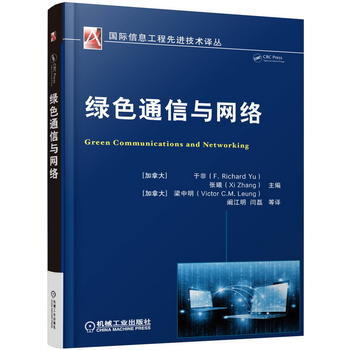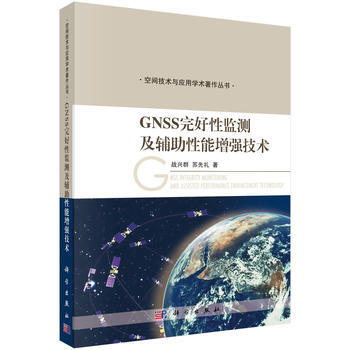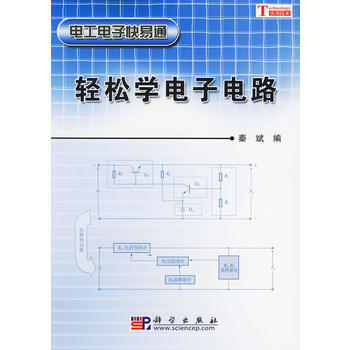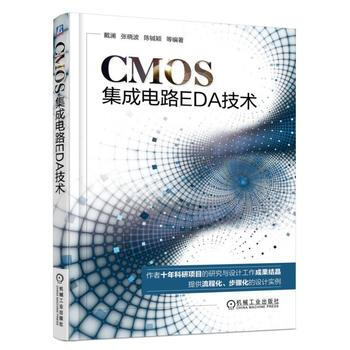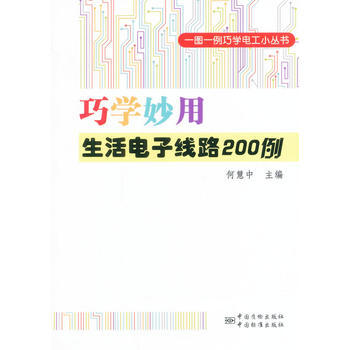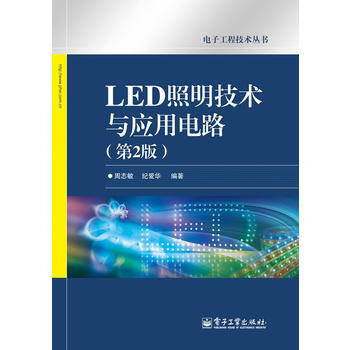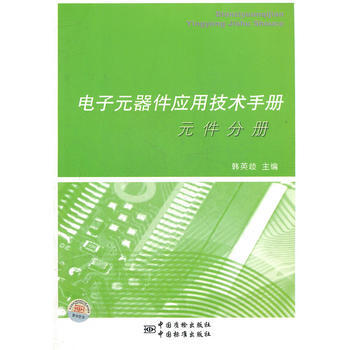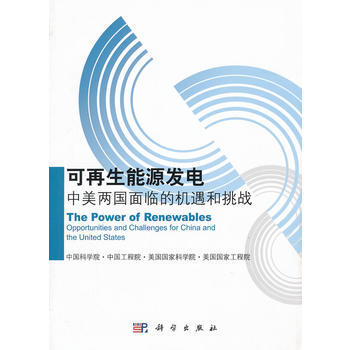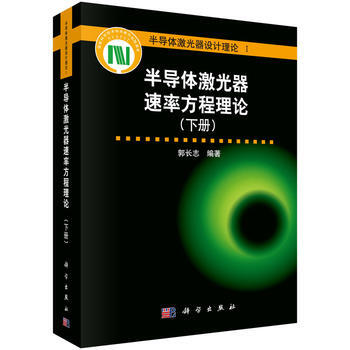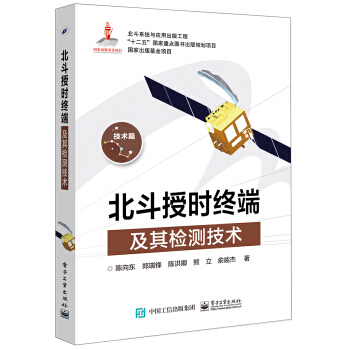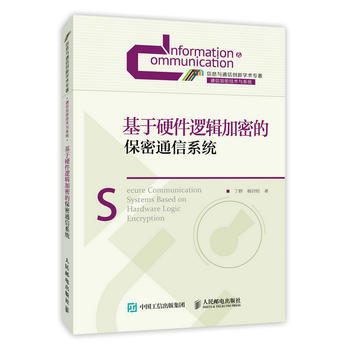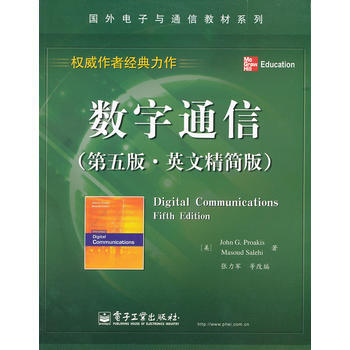

具体描述
基本信息
书名:数字通信(第五版 英文精简版)
定价:59.00元
作者:(美)普罗科斯,(美)萨利希,张力军 等改编
出版社:电子工业出版社
出版日期:2012-01-01
ISBN:9787121153259
字数:
页码:
版次:1
装帧:平装
开本:
商品重量:0.781kg
编辑推荐
内容提要
本书是在《数字通信(第五版)》的基础上,根据的实际教学情况进行精简和改编的。主要的精简原则为:保留信号传输理论内容,舍去信息传输理论内容,并以传统而经典的数字传输理论为主,无线通信为辅。改编的部分主要是根据实际教学的常用习惯来进行的。精简后的内容主要涵盖:确定与*信号分析;数字调制方法;AWGN信道的*接收机;载波和符号同步;通过带限信道的数字通信;自适应均衡;多信道和多载波系统;数字通信用扩频信号;衰落信道:信道特征与信号传输;多天线系统。
目录
Chapter 1Introduction
1.1 Elements of a Digital CommunicationSystem
1.2 Communication Channels and TheirCharacteristics
1.3 Mathematical Models for CommunicationChannels
1.4 A Historical Perspective in the Development of
Digitalommunications
Chapter 2 Deterministic and Random SignalAnalysis
2.1 Representation of Bandpass Signals andSystems
2.1–1 Representation of Bandpass Signals/ 2.1–2 Response of aBandpass System to a Bandpass Signal
2.2 Signal Space Representation ofWaveforms
2.2–1 Vector Space Concepts / 2.2–2 Signal Space Concepts / 2.2–3Orthogonal Expansions of Signals /2.2–4 Gram-SchmidtProcedure
2.3 Some Useful RandomVariables
2.4 RandomProcesses
2.4–1 Wide-Sense Stationary Random Processes /2.4–2Cyclostationary Random Processes
2.5 Series Expansion of RandomProcesses
2.5–1 Sampling Theorem for Band-Limited RandomProcesses /2.5–2 TheKarhunen-Lo`eve Expansion
2.6 Bandpass Stationary StochasticProcesses
Problems
Chapter 3 Digital ModulationSchemes
3.1 Representation of Digitally ModulatedSignals
3.2 Memoryless ModulationMethods
3.2–1 Pulse Amplitude Modulation (PAM) / 3.2–2 Phase Modulation /3.2–3 Quadrature Amplitude Modulation /3.2–4 MultidimensionalSignaling
3.3 Signaling Schemes withMemory
3.3–1 Continuous-Phase Frequency-Shift Keying(CPFSK) /
3.3–2 Continuous-Phase Modulation (CPM)
3.4 Power Spectrum of Digitally ModulatedSignals
3.4–1 Power Spectral Density of a Digitally ModulatedSignalwith
Memory / 3.4–2 Power Spectral Density of LinearlyModulated
Signals / 3.4–3 Power Spectral Density ofDigitally Modulated
Signals with Finite Memory / 3.4–4Power Spectral Density of
Modulation Schemes with a MarkovStructure / 3.4–5 Power
Spectral Densities of CPFSK and CPM Signals
Problems
Chapter 4 Optimum Receivers for AWGNChannels
4.1 Waveform and Vector ChannelModels
4.1–1 Optimal Detection for a General Vector Channel
4.2 Waveform and Vector AWGNChannels
4.2–1 Optimal Detection for the Vector AWGN Channel /4.2–2Implementation of the Optimal Receiver for AWGN Channels / 4.2–3 AUnion Bound on the Probability of Error of Maximum LikelihoodDetection
4.3 Optimal Detection and Error Probability for Band-Limited
Signaling
4.3–1 Optimal Detection and Error Probability for ASK or
PAM Signaling / 4.3–2 Optimal Detection and ErrorProbability
for PSK Signaling / 4.3–3 Optimal Detection and ErrorProbability
for QAM Signaling / 4.3–4 Demodulation and Detection
4.4 Optimal Detection and Error Probability forPower-Limited
Signaling
4.4–1 Optimal Detection and Error Probability for Orthogonal
Signaling / 4.4–2 Optimal Detection and Error Probabilityfor
Biorthogonal Signaling / 4.4–3 Optimal Detection and Error
Probability for Simplex Signaling
4.5 Optimal Detection in Presence of Uncertainty:Noncoherent
Detection
4.5–1 Noncoherent Detection of Carrier Modulated Signals /4.5–2Optimal Noncoherent Detection of FSK Modulated Signals / 4.5–3Error Probability of Orthogonal Signaling with NoncoherentDetection / 4.5–4 Probability of Error for Envelope Detection ofCorrelated Binary Signals /4.5–5 Differential PSK (DPSK)
4.6 A Comparison of Digital SignalingMethods
4.6–1 Bandwidth and Dimensionality
4.7 Lattices and Constellations Based onLattices
4.7–1 An Introduction to Lattices / 4.7–2 Signal Constellationsfrom Lattices
4.8 Detection of Signaling Schemes withMemory
4.8–1 The Maximum Likelihood Sequence Detector
4.9 Optimum Receiver for CPMSignals
4.9–1 Optimum Demodulation and Detection of CPM /4.9–2 Performanceof CPM Signals / 4.9–3 Suboptimum Demodulation and Detection of CPMSignals
Problems
Chapter 5 Carrier and SymbolSynchronization
5.1 Signal ParameterEstimation
5.1–1 The Likelihood Function / 5.1–2 Carrier Recovery and
Symbol Synchronization in Signal Demodulation
5.2 Carrier PhaseEstimation
5.2–1 Maximum-Likelihood Carrier Phase Estimation /5.2–2 ThePhase-Locked Loop / 5.2–3 Effect of AdditiveNoise on the PhaseEstimate / 5.2–4 Decision-Directed Loops / 5.2–5Non-Decision-Directed Loops
5.3 Symbol TimingEstimation
5.3–1 Maximum-Likelihood Timing Estimation /5.3–2Non-Decision-Directed Timing Estimation
5.4 Joint Estimation of Carrier Phase and SymbolTiming
5.5 Performance Characteristics of MLEstimators
Problems
Chapter 6 Digital Communication Through Band-LimitedChannels
6.1 Characterization of Band-LimitedChannels
6.2 Signal Design for Band-LimitedChannels
6.2–1 Design of Band-Limited Signals for No Intersymbol
Interference—The Nyquist Criterion / 6.2–2 Design of Band-LimitedSignals with Controlled ISI—Partial-Response Signals / 6.2–3 DataDetection for Controlled ISI /6.2–4 Signal Design for Channels withDistortion
6.3 Optimum Receiver for Channels with ISI andAWGN
6.3–1 Optimum Maximum-Likelihood Receiver /6.3–2 A Discrete-TimeModel for a Channel with ISI /6.3–3 Maximum-Likelihood SequenceEstimation (MLSE)
for the Discrete-Time White Noise Filter Model
6.4 LinearEqualization
6.4–1 Peak Distortion Criterion /6.4–2 Mean-Square-Error (MSE)Criterion /
6.4–3 Performance Characteristics of the MSE Equalizer /6.4–4Fractionally Spaced Equalizers /6.4–5 Baseband and Passband LinearEqualizers
6.5 Decision-FeedbackEqualization
6.5–1 Coefficient Optimization /6.5–2 Performance Characteristicsof DFE
6.6 Reduced Complexity MLDetectors
Problems
Chapter 7 AdaptiveEqualization
7.1 Adaptive LinearEqualizer
7.1–1 The Zero-Forcing Algorithm /7.1–2 The LMS Algorithm /7.1–3Convergence Properties of the LMS Algorithm /7.1–4 Excess MSE dueto Noisy Gradient Estimates /7.1–5 Accelerating the InitialConvergence Rate
in the LMS Algorithm / 7.1–6 Adaptive Fractionally SpacedEqualizer—The Tap Leakage Algorithm /7.1–7 An Adaptive ChannelEstimator for ML
Sequence Detection
7.2 Adaptive Decision-FeedbackEqualizer
7.3 Recursive Least-Squares Algorithms for AdaptiveEqualization
7.3–1 Recursive Least-Squares (Kalman) Algorithm /7.3–2 LinearPrediction and the Lattice Filter
Problems
Chapter 8 Multichannel and MulticarrierSystems
8.1 Multichannel Digital Communications in AWGNChannels
8.1–1 Binary Signals / 8.1–2 M-ary Orthogonal Signals
8.2 MulticarrierCommunications
8.2–1 Single-Carrier Versus Multicarrier Modulation /8.2–2Capacity of a Nonideal Linear Filter Channel /8.2–3 OrthogonalFrequency Division Multiplexing (OFDM) /8.2–4 Modulation andDemodulation in an OFDM System /
8.2–5 An FFT Algorithm Implementation of an OFDM System /8.2–6Spectral Characteristics of Multicarrier Signals /8.2–7 Bit andPower Allocation in Multicarrier Modulation /8.2–8 Peak-to-AverageRatio in Multicarrier Modulation /8.2–9 Channel CodingConsiderations in Multicarrier Modulation
Problems
Chapter 9 Spread Spectrum Signals for DigitalCommunications
9.1 Model of Spread Spectrum Digital CommunicationSystem
9.2 Direct Sequence Spread SpectrumSignals
9.2–1 Error Rate Performance of the Decoder /9.2–2 SomeApplications of DS Spread Spectrum Signals /9.2–3 Effect of PulsedInterference on DS Spread Spectrum Systems / 9.2–4 Excision ofNarrowband Interference in DS Spread Spectrum Systems / 9.2–5Generation of PN Sequences
9.3 Frequency-Hopped Spread SpectrumSignals
9.3–1 Performance of FH Spread Spectrum Signals in an
AWGN Channel / 9.3–2 Performance of FH Spread Spectrum
Signals in Partial-Band Interference / 9.3–3 A CDMA System
Based on FH Spread Spectrum Signals
9.4 Other Types of Spread SpectrumSignals
Problems
Chapter 10 Fading Channels : Characterization and
Signaling
10.1 Characterization of Fading MultipathChannels
10.1–1 Channel Correlation Functions and Power Spectra /
10.1–2 Statistical Models for Fading Channels
10.2 The Effect of Signal Characteristics on the Choice of aChannelModel
10.3 Frequency-Nonselective, Slowly FadingChannel
10.4 Diversity Techniques for Fading MultipathChannels
10.4–1 Binary Signals / 10.4–2 Multiphase Signals /10.4–3 M-aryOrthogonal Signals
10.5 Signaling over a Frequency-Selective, Slowly FadingChannel:
The RAKEemodulator
10.5–1 A Tapped-Delay-Line Channel Model / 10.5–2 The RAKEDemodulator / 10.5–3 Performance of RAKE Demodulator / 10.5–4Receiver Structures for Channels with IntersymbolInterference
10.6 Multicarrier Modulation(OFDM)
10.6–1 Performance Degradation of an OFDM System due to DopplerSpreading / 10.6–2 Suppression of ICI in OFDM Systems
Problems
Chapter 11 Multiple-AntennaSystems
11.1 Channel Models for Multiple-AntennaSystems
11.1–1 Signal Transmission Through a Slow FadingFrequency-Nonselective MIMO Channel / 11.1–2 Detection of DataSymbols in a MIMO System / 11.1–3 Signal
Transmission Through a Slow Fading Frequency-Selective MIMOChannel
11.2 Spread Spectrum Signals and MulticodeTransmission
11.2–1 Orthogonal Spreading Sequences /11.2–2 Multiplexing GainVersus Diversity Gain /11.2–3 Multicode MIMO Systems
Problems
作者介绍
文摘
序言
用户评价
在我看来,《数字通信(第五版 英文精简版)》是一本真正意义上的“少即是多”的典范。起初,我对于“精简版”这个标签有所保留,担心其内容会过于肤浅,无法满足我对数字通信深入理解的需求。然而,这本书完全打消了我的顾虑,甚至让我对其精简的编排方式赞不绝口。作者巧妙地将复杂的概念提炼出来,并通过逻辑清晰的结构呈现,使得读者能够以最有效率的方式掌握核心知识。我特别欣赏书中对于误差控制编码的讲解。不同于一些教材中繁杂的算法推导,这本书更侧重于解释编码的目的、基本思想以及它在提升通信系统可靠性方面的作用。作者通过直观的图示和简化的例子,让我快速理解了信道编码的核心理念,尤其是对于一些现代编码技术,如LDPC码和Turbo码,作者都能在有限的篇幅内,将其精髓扼要地呈现出来。此外,书中对于通信系统性能的分析部分,也让我受益匪浅。作者并没有一味地展示各种性能指标的计算公式,而是更注重解释这些指标的物理意义,以及它们是如何受到各种因素的影响。例如,在讨论误码率(BER)与信噪比(SNR)之间的关系时,作者通过生动的图示,清晰地展现了不同调制方式在不同SNR下的性能差异,这让我对信道条件对通信质量的影响有了更深刻的认识。这本书的英文写作风格也非常流畅自然,即便是对于非英语母语的读者,也能轻松理解。作者善于运用简洁的语言,避免了不必要的术语堆砌,使得阅读过程既高效又充满乐趣。总而言之,这本书以其精炼的语言、清晰的逻辑和深刻的见解,成功地为我提供了一个高效的学习路径,我强烈推荐给所有希望快速掌握数字通信核心知识的读者。
评分《数字通信(第五版 英文精简版)》这本书,对我而言,是一次惊喜的发现,更是一次思维的启迪。我曾几何时,在浩如烟海的通信理论知识面前感到迷茫,一本本厚重的教材,似乎总是难以抓住问题的核心。而这本“精简版”,却以其独特的视角和精炼的语言,将我从知识的迷雾中拉了出来。它不像其他书籍那样,将大量的篇幅用于繁复的数学推导,而是更侧重于勾勒出数字通信的整体框架和核心思想。我特别欣赏作者在引入信息论时所采取的策略。他并没有将信息论孤立开来,而是将其巧妙地融入到整个通信系统的设计中,让我们深刻理解信息论是如何指导着通信能力的理论边界。当我读到关于信道容量的讨论时,作者通过生动形象的比喻,让我瞬间领悟了香农公式背后蕴含的深刻意义,以及它如何为我们指明了通信优化的方向。书中对于各种编码技术的讲解,也让我耳目一新。不同于以往接触过的书籍中冗长的算法描述,这本书更侧重于解释编码的原理和目的,以及它在提升通信可靠性方面的作用。作者通过简化的例子,让我快速掌握了LDPC码和Turbo码等现代编码技术的核心思想,而无需沉溺于复杂的代数运算。此外,书中对于一些实际通信系统的讨论,也让我看到了理论与实践的紧密结合。例如,在讨论多径传播对信号的影响时,作者引用了移动通信中均衡器的设计思路,这让我对课程内容有了更直观的理解。这本书的英文写作风格也非常流畅自然,即便是对于非英语母语的读者,也能轻松理解。作者善于运用简洁的语言,避免了不必要的术语堆砌,使得阅读过程充满了探索的乐趣,而不是被动地接受信息。总而言之,这本书以其精炼的语言、清晰的逻辑和深刻的见解,成功地为我提供了一个高效的学习路径,我强烈推荐给所有希望快速掌握数字通信核心知识的读者。
评分我必须说,《数字通信(第五版 英文精简版)》这本书给了我一个意想不到的惊喜。我曾一度担心“精简版”会意味着内容的删减和理论的浅尝辄止,然而,事实证明我的担忧是多余的。这本书的作者以一种非常巧妙的方式,在保持知识体系完整性的同时,将内容浓缩到了最精华的部分。它就像一个高度提炼的精华液,将数字通信的核心概念和关键技术以最直接、最有效的方式呈现给读者。我特别欣赏作者在处理一些经典理论时所采取的 pendekatan。比如,在介绍数字调制技术时,作者并没有陷入各种调制方式的细节泥潭,而是着重分析了它们在频谱效率、功率效率以及抗干扰能力等方面的权衡,这让我在短时间内就能对不同调制方式的优劣有一个清晰的认识。这种宏观的视角,对于建立整体的知识框架非常有帮助。书中对于信道编码的讲解也让我印象深刻。我过去常常在各种纠错码的算法细节中迷失,而这本书则着重于阐述编码的目的、基本原理以及它如何提升通信系统的可靠性。作者通过一些简化的例子,让我得以快速掌握LDPC码和Turbo码等现代编码技术的核心思想,而无需沉溺于复杂的代数运算。此外,书中对于一些实际通信系统的讨论,也让我看到了理论与实践的紧密结合。例如,在讨论多径传播对信号的影响时,作者引用了移动通信中均衡器的设计思路,这让我对课程内容有了更直观的理解。这本书的语言风格也非常独特,虽然是英文原版,但其表述清晰流畅,即便是非英语母语的读者也能轻松理解。作者善于使用简洁明了的语言,避免了不必要的术语,使得阅读过程充满了一种探索的乐趣。总而言之,这本书以其精炼的语言、清晰的逻辑和深刻的见解,成功地为我打开了数字通信领域的一扇新窗口,我强烈推荐给所有希望深入了解这一领域的读者。
评分对于《数字通信(第五版 英文精简版)》,我的初步印象是,它是一本能够真正触及灵魂的书。我之所以这么说,是因为它不仅仅是在传授知识,更是在引导读者去理解数字通信的本质和思想。这本书的“精简”之处,并非简单的删减,而是如同精心雕琢的艺术品,去除了所有不必要的冗余,只留下最核心、最具价值的部分。作者在开篇就明确了数字通信的全局图景,让我们在开始学习具体技术之前,就已经对整个学科的脉络有了清晰的认识。我尤其喜欢作者在讲解采样定理时所采用的类比,它将一个看似枯燥的数学原理,转化为一个生动的故事,让我瞬间领悟了“奈奎斯特频率”背后的物理意义。这种教学方式,极大地降低了理解的门槛,也激发了我深入探索的兴趣。书中对于信息论的介绍,更是让我眼前一亮。作者并没有将信息论仅仅作为一种数学工具来对待,而是深刻地剖析了它在通信系统中扮演的角色,以及它如何为我们提供通信能力的理论上限。这种高度的哲学思考,让我对数字通信有了更深层次的理解。当读到章节末尾的习题时,我发现它们的设计也十分巧妙,往往能够引导我思考更广泛的问题,而不是仅仅停留在公式的计算上。尽管这是一本英文书籍,但其语言风格却出奇的清晰和富有吸引力。作者善于运用富有洞察力的语句,将复杂的概念娓娓道来,让我有种与智者对话的感觉。这本书不仅教会了我数字通信的知识,更重要的是,它塑造了我看待这个领域的视角,让我看到了隐藏在数据流背后的深刻原理。它是一本值得反复品读的书,每次阅读都会有新的收获。
评分《数字通信(第五版 英文精简版)》这本书,可以说是我近期阅读体验中最具颠覆性的一本。我之所以这么说,是因为它以一种极其精炼而又富有洞察力的方式,将数字通信的核心思想和关键技术呈现在我面前,完全打破了我以往对“精简版”的刻板印象。作者在开篇就为我们勾勒出了数字通信的宏大图景,让我们在开始学习具体技术之前,就已经对整个学科的脉络有了清晰的认识。我尤其喜欢作者在讲解信号量化时所采用的类比,它将一个看似枯燥的数学原理,转化为一个生动的故事,让我瞬间领悟了“奈奎斯特频率”背后的物理意义。这种教学方式,极大地降低了理解的门槛,也激发了我深入探索的兴趣。书中对于信息论的介绍,更是让我眼前一亮。作者并没有将信息论仅仅作为一种数学工具来对待,而是深刻地剖析了它在通信系统中扮演的角色,以及它如何为我们提供通信能力的理论上限。这种高度的哲学思考,让我对数字通信有了更深层次的理解。当我读到章节末尾的习题时,我发现它们的设计也十分巧妙,往往能够引导我思考更广泛的问题,而不是仅仅停留在公式的计算上。尽管这是一本英文书籍,但其语言风格却出奇的清晰和富有吸引力。作者善于运用富有洞察力的语句,将复杂的概念娓娓道来,让我有种与智者对话的感觉。这本书不仅教会了我数字通信的知识,更重要的是,它塑造了我看待这个领域的视角,让我看到了隐藏在数据流背后的深刻原理。它是一本值得反复品读的书,每次阅读都会有新的收获。
评分当我拿起《数字通信(第五版 英文精简版)》这本书时,我的脑海里闪过一丝犹豫:“精简版”是否意味着内容的缺失,会错过一些关键的知识点?然而,这种疑虑很快就被这本书精湛的内容组织和深刻的洞察力所驱散。作者以一种令人惊叹的精准度,将数字通信的核心概念提炼出来,并以一种流畅且富有逻辑的方式呈现。我尤其欣赏作者在讲解信号处理部分时所采取的 pendekatan。他并没有陷入各种傅里叶变换和卷积的繁琐细节,而是着重阐述了它们在信号分析和系统建模中的作用。例如,在介绍采样定理时,作者通过生动的类比,让我瞬间理解了为何需要以两倍的最高频率进行采样,以及欠采样可能带来的后果。这种直观的解释方式,极大地降低了理解的门槛,也激发了我进一步探索的兴趣。书中对信道编码的讨论也让我印象深刻。作者并非仅仅罗列各种编码算法,而是着重于解释编码的本质——如何通过增加冗余来对抗噪声和干扰,从而提高通信的可靠性。他以一种高度概括的方式,介绍了LDPC码和Turbo码等现代编码技术的优势,让我得以快速掌握这些技术的核心思想,而无需深入研究其复杂的数学原理。此外,书中对于信息论的阐释也十分到位。作者并非将其作为一个独立的数学分支来介绍,而是将其视为数字通信的基石,深刻地揭示了信息论在通信系统设计中的指导作用。他通过对信道容量的讨论,让我得以窥见通信能力的理论极限,以及如何在实际系统中逼近这一极限。这本书的英文写作风格也非常出色,简洁而富有力量,即便是初学者也能轻松上手。作者善于运用精准的词汇和清晰的句式,将复杂的概念解释得明明白白,让我有一种与智者对话的感觉。总而言之,这本书以其精炼的语言、清晰的逻辑和深刻的见解,成功地为我打开了数字通信领域的一扇新窗口,我强烈推荐给所有希望深入了解这一领域的读者。
评分第一次接触《数字通信(第五版 英文精简版)》时,我的内心是带着一丝好奇与些许的疑虑。我之前接触过的相关书籍,大多内容详尽,但随之而来的是大量的公式推导和理论细节,往往让人望而生畏。这本书的“精简版”标签,反而勾起了我的兴趣,我好奇作者如何能在有限的篇幅内,清晰地阐述如此庞杂的学科。令我惊喜的是,这本书完全超出了我的预期。它并没有因为“精简”而牺牲内容的深度,反而通过一种高度概括和提炼的方式,将数字通信的核心理念和关键技术以一种更加易于理解和吸收的方式呈现。我尤其欣赏作者在讲解一些基础原理时所采取的“自顶向下”的方法。他并没有直接抛出复杂的数学公式,而是首先勾勒出数字通信系统的整体架构,然后逐步深入到各个模块的原理。例如,在介绍数字调制时,作者并没有逐一列举所有调制方式的细节,而是重点分析了它们在频谱效率、功率效率和实现复杂度等方面的权衡,这让我能够快速地建立起对不同调制方式的整体认知。书中对信道编码的讲解也让我印象深刻。作者用简洁的语言解释了纠错码的基本思想,以及它如何提高通信系统的鲁棒性。他通过一些直观的例子,让我得以快速掌握LDPC码和Turbo码等现代编码技术的精髓,而无需陷入繁杂的代数运算。这本书的语言风格也十分出色,虽然是英文原版,但其表述清晰流畅,即便是对英语不太熟练的读者也能轻松理解。作者善于运用简洁的语言,避免了不必要的术语堆砌,使得阅读过程充满了探索的乐趣,而不是被动地接受信息。总而言之,这本书以其精炼的语言、清晰的逻辑和深刻的见解,成功地为我打开了数字通信领域的一扇新窗口,它在保持学术严谨性的同时,又充满了实践指导意义,对于任何想要深入了解数字通信的人来说,都是一份宝贵的财富。
评分这本书绝对是我近期阅读体验中最具颠覆性的一本。当初拿到《数字通信(第五版 英文精简版)》的时候,我并没有抱有多大的期待,毕竟“精简版”这三个字往往意味着删减和浅尝辄止。然而,事实证明我的顾虑是多余的,甚至可以说是大错特错。作者在保持核心概念清晰透彻的同时,将一些冗余的细节巧妙地剥离,使得整本书读起来丝毫不显拖沓,反而有一种行云流水般的流畅感。我尤其欣赏的是作者在解释一些复杂的数学模型时,并没有直接抛出公式,而是循序渐进地引导读者理解其背后的逻辑和物理意义。例如,在介绍信道编码的部分,我过去常常被那些繁复的校验位计算弄得头昏脑胀,但这本书通过生动的类比和直观的图示,让我瞬间领悟到了纠错码的精髓。更让我惊喜的是,书中在讨论现代通信系统时,并没有回避一些前沿的技术,比如OFDM的原理在低功耗物联网设备中的应用,以及5G NR中的某些关键技术特性。虽然是“精简版”,但其知识的广度和深度并没有因此打折扣,反而因为这种聚焦,使得读者能够更快地掌握最核心的知识点,为进一步深入研究打下了坚实的基础。这本书就像一个经验丰富的向导,带领我在数字通信的迷宫中快速找到方向,而不是让我迷失在各种细枝末节中。它的语言风格简洁明了,即便是非专业背景的读者,只要具备一定的数学基础,也能从中受益匪浅。我可以说,这本“精简版”反而是我读过的同类书籍中最具启发性的一本,它成功地将复杂的技术概念变得易于理解和消化,极大地提升了我的学习效率和兴趣。
评分《数字通信(第五版 英文精简版)》这本书,在我看来,是一次知识的“瘦身”与“重塑”。我曾阅读过不少关于数字通信的教材,它们大多内容详实,但也因此显得冗长,往往让我在繁杂的细节中迷失方向。而这本“精简版”则以一种截然不同的方式,将数字通信的核心知识提炼出来,并通过一种极其精炼而又富有洞察力的方式呈现。作者在处理一些基础概念时,并没有回避其背后的数学原理,但却能够巧妙地将其与直观的物理意义联系起来,使得理解过程顺畅无比。例如,在讲解信号的离散化和量化时,作者通过生动形象的比喻,让我瞬间领悟了模拟信号向数字信号转换的本质,以及采样率和量化位数对信息保真度的影响。我特别喜欢书中对信息论部分的阐释。作者并没有仅仅将其作为一个独立的章节来介绍,而是将其融入到整个数字通信的框架中,深刻地揭示了信息论在通信系统设计中的指导作用。他通过对香农信息率的讨论,让我得以窥见通信能力的理论极限,以及如何在实际系统中逼近这一极限。更让我感到惊喜的是,书中对于现代通信系统的一些关键技术的介绍,尽管篇幅有限,但却能够点到核心,让我对OFDM、MIMO等技术有了初步但深刻的理解。这本书的语言风格也十分独特,虽然是英文原版,但其表述简洁而有力,充满了逻辑性和启发性。作者善于使用简短而精准的句子,将复杂的概念解释得明明白白,让我有种豁然开朗的感觉。总而言之,这本书以其独特的“精简”之道,让我重新认识了数字通信,它不仅传授了知识,更重要的是,它塑造了我理解这一学科的思维方式,是一本真正值得反复阅读的佳作。
评分当我第一次翻开《数字通信(第五版 英文精简版)》时,我脑海里闪过的第一个念头是:“这本‘精简版’到底能有多‘精简’?” 作为一名在通信领域摸爬滚打了多年的工程师,我深知这个领域的庞杂与精深,任何一本试图涵盖所有内容的教材都可能变得臃肿不堪。然而,这本书以一种出人意料的方式打破了我的固有认知。它并没有因为“精简”而牺牲内容的深度和完整性,反而通过一种更加聚焦、更加提纲挈领的方式,将数字通信的核心思想和关键技术一一呈现。我特别喜欢作者在构建知识体系时所采用的逻辑顺序。从最基础的信号表示和采样定理,到复杂的编码调制技术,再到最后的信道模型和性能分析,每一步都衔接得非常自然,仿佛在为读者搭建一座坚实的知识阶梯。尤其是在介绍信息论的部分,作者并没有一味地堆砌公式,而是花了大量的篇幅去阐述香农定理的深远意义,以及它如何指导着现代通信系统的设计。这种对理论根源的深刻挖掘,让我对整个学科的理解上升到了一个新的高度。书中穿插的大量实例,更是让抽象的概念变得鲜活起来。比如,在讲解误码率(BER)与信噪比(SNR)的关系时,作者引用了Wi-Fi信号在不同环境下的实际衰减情况,这让我深刻体会到理论模型与实际应用之间的紧密联系。即便这本书是英文原版,其语言表达也十分清晰,甚至比一些翻译过来的中文书籍更加易懂。作者善于运用简洁的句子和精准的词汇,避免了不必要的术语堆砌,使得阅读过程充满了探索的乐趣,而不是被动地接受信息。这本书无疑是数字通信领域一本不可多得的佳作,它在保持学术严谨性的同时,又充满了实践指导意义,对于任何想要深入了解数字通信的人来说,都是一份宝贵的财富。
相关图书
本站所有内容均为互联网搜索引擎提供的公开搜索信息,本站不存储任何数据与内容,任何内容与数据均与本站无关,如有需要请联系相关搜索引擎包括但不限于百度,google,bing,sogou 等,本站所有链接都为正版商品购买链接。
© 2025 windowsfront.com All Rights Reserved. 静流书站 版权所有






